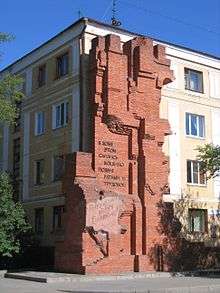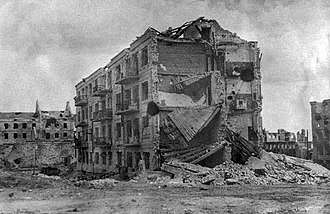Pavlov's House
Pavlov's House (Russian: дом Павлова tr. Dom Pavlova) was a fortified apartment building which Red Army defenders held for 60 days against a heavy Wehrmacht offensive during the Battle of Stalingrad. The siege lasted from 27 September to 25 November 1942 and eventually the Red Army managed to relieve it from the siege.[1]

It gained its popular name from Sergeant Yakov Pavlov, who commanded the platoon that seized the building and defended it during the long battle.[2]
Siege
The house was a four-story building in the center of Stalingrad, built perpendicular to the embankment of the river Volga and overseeing the "9th January Square", a large square named for Bloody Sunday. In late September 1942, between 30 and 50 soldiers of the 42nd Guards Regiment, 13th Guards Division secured the large apartment blocks from German control, following its reconnoiter by four soldiers four days prior which Yakov Pavlov himself led.
The position was quickly fortified under the command of Lieutenant Ivan F. Afanasiev, who ordered the men to lay land mines in all approaches to the square, barbed wire around the perimeter of the apartment block, and to position multiple machine guns in the windows as well as a PTRS anti tank rifle. The Soviets also had large amounts of artillery support from the opposite side of the Volga. Supply and communication trenches were created leading from the rear of Pavlov’s House to the river bank of the Volga, which would receive supply from supply vessels which were often barraged by German artillery when crossing the river.[3][4]
The strategic benefit of the house was that it defended a key section of the Volga bank. The tactical benefit of the house was its position on a cross-street, giving the defenders a 1 km (0.62 mi) line of sight to the north, south and west.[5] After several days, reinforcements and resupply arrived for Pavlov's men, bringing the unit up to a 25-man understrength platoon and equipping the defenders with machine guns, anti-tank rifles, and mortars.

In keeping with Stalin's Order No. 227—"not one step back"—Sergeant Pavlov was ordered to fortify the building and defend it to the last bullet and the last man. Taking this advice to heart, Pavlov ordered the building to be surrounded with four layers of barbed wire and minefields, and set up machine-gun posts in every available window facing the square. In the early stages of the defense, Pavlov discovered that an anti-tank rifle—a PTRS-41—he had mounted on the roof was particularly effective when used to ambush unsuspecting German tanks; once the tanks had approached to within range of the building, their thin turret-roof armor became exposed to AT rifle fire from above, and they were unable to elevate their weapons enough to retaliate.[6]
For better internal communication, Pavlov's soldiers breached the walls in the basement and upper floors, and dug a communications trench to Soviet positions outside. Supplies were brought in via the trench or by boats crossing the river, defying German air raids and shelling. Nevertheless, food and especially water was in short supply. Lacking beds, the soldiers tried to sleep on insulation wool torn off pipes but were subjected to harassing fire every night in order to try to break their resistance.
The Germans attacked the building several times a day. Each time German infantry or tanks tried to cross the square and to close in on the house, Pavlov's men laid down a withering barrage of machine gun and AT rifle fire from the basement, the windows and the roof. The defenders, as well as the civilians hiding in the basement, were eventually relieved by counter-attacking Soviet forces after holding out from 27 September to 25 November 1942.
Uncertainty on dates
Sources conflict on the date at which the siege began, and the date at which the Soviet reinforcements reached the building and lifted the siege.
"On September 27, a 30-man Russian platoon was ordered to retake a four-story apartment building the Germans had just captured..... until November 25, 1942, [...]"[7]
"[...] the defenders of Pavlov's House who participated in it's [sic] defense from 26 September 1942 till 25 November 1942."[8]
"The defense of the house lasted for 58 days and nights."[1]
Symbolic meaning
Pavlov's House became a symbol of the stubborn and dogged resistance of the Soviet forces during the Battle of Stalingrad, which eventually ended in a decisive victory for the Soviet forces after months of massive casualties on both sides. The inability of the German blitzkrieg to make headway against such grinding and self-sacrificial attrition warfare made the failure to capture Pavlov's House (despite numerous attempts) stand out as a symbol of resistance against a vastly superior force.
Vasily Chuikov, commanding general of the Soviet forces in Stalingrad, later joked that the Germans lost more men trying to take Pavlov's House than they did taking Paris.[9][10][11]
Pavlov's "House" was rebuilt after the battle and is still used as an apartment building today. There is an attached memorial constructed from bricks picked up after the battle on the East side facing the Volga.
Pavlov was awarded the title Hero of the Soviet Union for his actions.[12]
Recent reporting
A Russian TV documentary in 2009, Legendary Redoubt, (Легендарный редут) on the Russian Channel One reported on Pavlov's House. According to the documentary, the house's defense was in fact led by Lieutenant Ivan F. Afanasiev (Иван Ф. Афанасьев). This report does not discount Pavlov's efforts, which led to his earning the Hero of the Soviet Union and those soldiers who took part in the defense, earning numerous decorations of their own. The last member of Pavlov's group, Kamoljon Turgunov from Turakurgan District, Namangan Province, Uzbekistan died on 16 March 2015, aged 93.[13]
See also
- Sihang Warehouse
References
- Sputnik. "Surviving the hell of Stalingrad". sputniknews.com. Retrieved 2 December 2016.
- Bull, Stephen (20 December 2012). World War II Street-Fighting Tactics. Bloomsbury Publishing. ISBN 9781782008460.
- Mathews, R. (2012). Stalingrad: The Battle that Shattered Hitler's Dream of World Domination. Arcturus Publishing Limited.
- Beevor, A. (1999). Stalingrad: The Fateful Siege, 1942–1943. London: Penguin Books.
- http://www.volfoto.ru/volgograd/ploschad_lenina/dom_pavlova/ Pavlov House in Russian
- Yoder, Mike (4 February 2003). "Battle of Stalingrad". Military History Online. Archived from the original on 14 May 2019. Retrieved 13 July 2019.
- "World War 2 History: Pavlov's House in Stalingrad-- They Shall Not Pass". Owlcation. Retrieved 2 December 2016.
- Rottiers, Geert. "Pavlov's house". www.stalingrad.net. Retrieved 2 December 2016.
- Chuikov, Vasily. Сражение века (in Russian). Retrieved 30 May 2013.
Эта небольшая группа, обороняя один дом, уничтожила вражеских солдат больше, чем гитлеровцы потеряли при взятии Парижа.
- World History. Т. Х. М., 1965, page. 43
- "European Cultural Benefits" (in Russian). Archived from the original on 3 October 2009.
- «Yakov Pavlov 10.17.1917 - 29.09.1981 Hero of the Soviet Union» in Russian
- "Ушел из жизни последний защитник дома Павлова в Сталинграде Камолжон Тургунов". Komsomolskaya Pravda (in Russian). 17 March 2015. Retrieved 4 December 2018.
External links
| Wikimedia Commons has media related to Pavlov's House. |